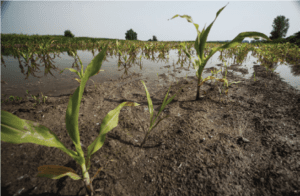Many areas across the AgVenture network and Midwest have seen an abundance of recent rainfall, presenting a formidable challenge to farmers and their crops. Some areas have long been listed on state drought monitors, so while the rain is initially welcomed to drought regions– some areas are getting an excess of 5+ inches which has quickly waterlogged young fields. We’ll explore what you should know and what steps you can take if you find your fields in this situation.
 Flooding affects fields differently based on a variety of factors. Young corn (before V6 stage) is most susceptible to flooding damage and typically can survive flooded conditions only up to four days. If the air temperature exceeds 75°F, flooded corn plants are unlikely to survive longer than 24 hours.
Flooding affects fields differently based on a variety of factors. Young corn (before V6 stage) is most susceptible to flooding damage and typically can survive flooded conditions only up to four days. If the air temperature exceeds 75°F, flooded corn plants are unlikely to survive longer than 24 hours.
What you should know
- When flooding occurs, less oxygen is available in the soil. Without oxygen, plants can’t uptake nutrients and water, which also make seedlings more sensitive to disease, insects, and herbicides.
- Excess moisture during early vegetative stages can slow corn root development. If a dry summer follows flooding, plants are unlikely to survive, because root systems aren’t developed enough to access soil moisture.
- Flooding damages corn biochemically. By impairing mitochondria, it causes release of free radicals which damage cell membranes.
- Flooded corn plants are unlikely to survive longer than 24 hours if the air is above 75°F, with smaller seedlings suffering the most damage. Warmer temperatures decrease the amount of oxygen in the soil. Cooler temperatures keep oxygen available and can prolong the life of the plant up to four days.
- Many pathogens such as Pythium thrive in standing water. Seedlings that are weakened by flooding or cold damage are more likely to succumb to disease if the pathogen is present.
Action steps
- Monitor for diseases: Corn that survives flooding is at higher risk of diseases such as pythium, corn smut and crazy top. Scout flood-affected fields closely, as they may need to be harvested early and at higher moisture levels to reduce yield losses.
- Apply nitrogen: Nitrogen (N) loss can result from prolonged ponding or saturated fields. N-deficient areas should be side-dressed with supplemental N as soon as possible.
- Scout fields: Closely monitor corn that has been fully submerged to assess plant survival. Split and examine the lower stem. It should be white to cream-colored. Darkening or softening of the tissue often precedes plant death. If corn has not yet emerged, continued leaf growth 3-5 days after water drains is a good sign of survival.
- Consider a fungicide treatment: A fungicide treatment prior to tassel can provide both a preventative and curative action to reduce yield losses. Need a recommendation on which products offer the best results according to the experiences of our team of experts? Bring this topic up in conversations with your local AgVenture Independent Seed Company or your AgVenture Yield Specialist.